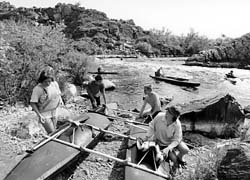The travel season is off to a good start

In his opening statement at last week’s meeting in Sevastopol to address the question of developing Ukraine’s tourism and resort industry, Prime Minister Viktor Yanukovych stressed the need to attract investment to Ukraine’s resort business on a large scale. To quote him, this will improve the quality of tourist services and make them cheaper. According to the government’s press service, tourism pours an annual $400 million into state coffers. Yet, investment in the tourism and resort sector is currently below $100 million a year.
A key argument put forward by the premier is that spas and resorts that are in lamentable condition and cannot provide adequate recreation services should be removed from the ministries to which they are subordinated and transferred to the State Tourism Administration, whose task would be to find investors. The premier then signed an appropriate directive in Sevastopol. However, so far this undertaking does not seem feasible, as the government will have to consider providing low-interest loans to businessmen who would build or renovate tourist centers, or even award them tax breaks for as long as three to five years. Yet Ukraine would not be the first country to do this: lawmakers in Malta, Spain, Portugal, Turkey, and other countries have created similar incentives for their tourist industry. Incidentally, only 10% of Ukraine’s 6,200 hotel beds — more than the number of available beds in Turkey — meet European standards.
Understandably, even such a promising sector as tourism (which in some countries accounts for between 10% and 20% of budget revenues) cannot expect to receive everything at once from the government. Luckily, last year lawmakers amended Ukraine’s Tourism Law, finally laying down the rules of the game in this sector and introducing a client protection system. They also made the groundbreaking decision to scrap the hotel tax. Before that, hotels had to pay up to 20% of their pretax profits to the local budgets, which kept prices unreasonably high. However, unfavorable investment conditions are making themselves felt even now, with Crimean resort prices up by 15% from last year. Experts say that this year vacations in the Crimea will cost between 10% and 20% more, which means that a stay on the peninsula will cost more than holidays on either the Turkish or Bulgarian seacoasts. This is chiefly due to the need to invest money in the infrastructure. After all, swimming pools at Crimean hotels would make the holiday season last six or seven months instead of the current two or three months. More and more people want to spend their vacation in the Crimea, especially foreigners. For example, two chartered flights take German tourists to the Crimea every week. But there is nowhere to put them, because only a handful of new tourist centers have been built in the last decade. Moreover, there are only between forty and fifty holiday homes and tourist centers open year- round.
Yet, the State Tourism Administration is overly optimistic, in particular because last year saw an almost 20% increase in the number of foreign tourists from neighboring countries and a 50% increase in the number of holidaymakers from overseas. Yet, this year fewer Russian tourists are expected. The most frequent visitors to Ukraine, Russians accounted for 2.85 million tourists out of almost 13 million tourists who vacationed in Ukraine last year. In an interview with UT 1 television, State Tourism Administration Chairman Valery Tsybukh said that one should not rule out the fact that the accident at the armaments depot in Zaporizhzhia oblast may affect the influx of tourists, whose route passes through this region along the Moscow- Simferopol highway. On the other hand, Mr. Tsybukh predicts that EU enlargement will positively affect the influx of foreign tourists, since prices for tourist services in new EU member-countries will increase significantly. For example, even today residents of such mountainous countries as Switzerland, Austria, and Poland vacation in the Carpathians. Aside from the Crimea, there are good prospects for Odesa and Kherson oblasts and the Azov seacoast. Even Berdiansk is ready to meet the demands of both tourists of modest means (at 110 hryvnias per two-bed hotel rooms, cockroaches free of charge) and fastidious vacationers (at 700 hryvnias per night in a two-bed room in a seafront hotel).
Meeting demands, including, so to speak, intellectual ones, is an especially relevant issue, historical and cultural tourism being one of the more popular sectors of the travel industry. For example, many tourists came to Kamyanets-Podilsky during this year’s May holidays in Ukraine, only to find that all the local hotels were packed. This is further proof that although one can only rejoice at the town’s popularity, its tourist infrastructure has yet to be developed.
Finally, a word about the main attractions slated for summer 2004. This year, apart from the popular Crimea and Carpathians, Volyn and Ternopil oblasts are featured. It is worth noting that last year the Ternopil region managed to double its share of tourists. Volyn’s calling card includes the Shatsk lakes with their glycerin-rich waters and its main attraction, Lake Svitiaz. Ternopil offers catamaran sailing down the Dnister and camping adventures, horseback riding through the Medobory mountains, castles (Ternopil oblast is home to thirty- four castles or 30% of all castles in Ukraine), and cave exploration trips known as speleotourism. Ternopil oblast is also home to Optimistic, Europe’s longest karstic cave, which stretches for 220 kilometers. The only downside that travelers must be prepared for are bad roads, but this is a topic for a separate lengthy discussion.






